
Long Round Pieces (reverse side) from Puzzle #56

Long Round pieces from Puzzle #430
|
Custom Puzzle Craft Maker of Fine Wooden Jigsaw Puzzles |
|
Custom Puzzle Craft is permanently closed to new orders.
Introduction
In year 2000, my first year of puzzle cutting, I learned about myself as a puzzle cutter - I developed clear and distinctive cutting styles for puzzle piece shapes. From my initial meanderings and geometric cutting exercises, two styles developed early on and solidified: Long Round and Swirl Curl. My third style, Creative Style, evolve from Swirl Curl via intermediate styles of Open / Flow Curl and came into full flower in 2001. Creative Style contains exuberant, elaborate pieces artistically blended with Curl Swirl and sometimes angular pieces cut using "Flow Cutting Principles" I've developed along the way. Later, in 2004 I introduced a variant of a traditional cutting style; I named my variant style Grid Line.
The Long Round, Swirl Curl, Creative and Grid Line cutting styles are the jigsaw puzzle piece cutting styles you may choose from when ordering a puzzle in the Custom Puzzles section. I also make "corporate" Grid Cut puzzles, currently by request. I added another style, Angular, in late 2004, this style may also be ordered upon request.
On this webpage I describe my three cutting styles in detail. Afterwards, I discuss some other cutting styles and some additional cutting techniques and features, plus a historical section on Open / Flow Curl.
For background information about jigsaw puzzle cutting styles, Bob Armstrong, a collector, seller, exhibitor and restorer of old jigsaw puzzles has a great jigsaw puzzle website which contains an article he wrote about Cutting Styles. You may read it here.
Bob Armstrong, describes this style as a result of a process whereby "the cutter consistently saws within a short distance of his/her previous cut [...]. The result is usually longer, thinner pieces, or pieces with long, thin arms, distinctly different from the block or 'chunky' shaped pieces associated with knob cutting. The choice of line contour combined with this approach creates recognizable overall patterns to the puzzle which I call long/angular, long/round, long/jagged, long/wavy, long/bumpy, long/foot, and scroll". I like Bob's term "Long Round", and adopted the name for this style, although in retrospect this style is also similar to "long/foot".

Long Round Pieces (reverse side) from Puzzle #56

Long Round pieces from Puzzle #430
I like to cut pieces in this style quite small, but you may order pieces in this style in a variety of sizes. In the picture, above, I cut the style at about 3 pieces per square inch, so a 12" by 10" puzzle cut in this style will have around 360 pieces.
The pieces have the least variation of any of my styles, thus I tend to use this style for more pastoral or serene scenes, while the other styles tend to be used more dynamic and sensual scenes. The uniform nature of the cut also makes this style more difficult to assemble. This style is highly interlocking and puzzles cut in this style usually may be easily picked up by a corner without any pieces falling out.
Major Long Round Puzzles
Puzzle #17 - My first major Long Round puzzle
Puzzle #52 - A nearly 800 piece Long Round puzzle
Puzzle #149 - A massive complex puzzle with over 1800 pieces.
I developed this style from a picture of a Madmar Puzzle I once had, cut in a somewhat similar style. My pieces tend to be a more uniformly "snaky", and have fewer flattened bulbs common to the Madmar style.

While Long Round was derived from memories of an old Madmar puzzle I once owned, Swirl Curl developed from within myself while I was practicing a Long Round puzzle. The initial breakthrough came in puzzle #10 (February 2000), one of a series of puzzles I cut from pages taken from a book of bird paintings, this one from "Dark Sky (canvasback) 1980" by Maynard Reece,. I cut the puzzle going from left to right. On the left-hand side is one of my earliest efforts at Long Round. By the time I reached the right-hand side some fluid curls were emerging! I then saved this experience, and cut a few more Long Round and Geometric Cut puzzles before I cut number puzzle #15, which was a huge breakthrough in the development of Swirl Curl - and was the puzzle from which the Swirl Curl name was born.

Puzzle #10 - Genesis of Swirl Curl
Dark Sky (canvasback) 1980 © Maynard Reece
![]()
A Curl
While cutting the historic puzzle #15, my first all-curl puzzle, I quickly realized that there are two parts to a curl puzzle - the curl itself and the path from one curl to another. I liked to put a Swirl between the curls, hence the name "Swirl Curl". I might cut three clockwise curls in a row and then a counter clockwise curl. I call the path between the two reversing curls the "reversal" and I found that there is a huge variety of possibilities for executing the reversal. The path from curl to curl tends to become more exuberant when a reversal occurs.
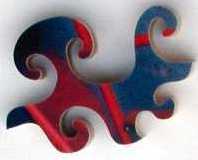
A particularly excellent "Mushroom Reversal" Swirl Curl Piece
From Puzzle #18 "Ghost of Florence", the first puzzle I ever sold! - and my third Swirl Curl puzzle

Swirl Curl in Puzzle #358 - Picasso's The Three Musicians
A large impressive Swirl Curl puzzle
Curl reversals may have beautiful round protruding knobs, other times a low lying mushroom may appear. When curls in the same direction are near each other, an "S Swirl" can form, in the classic "scroll cut" style. I find that during jigsaw puzzle cutting, sometimes when a piece is emerging from the board, it will complement a nearby cut, forming some local symmetry. So sometimes if one piece has a nice circular cul-de-sac knob reversal, several more may appear in the general vicinity. I've found that knobs of the curl and cul-de-sac variety when combined with longer, graceful swirls, produce an elegant mixture of pieces. In Swirl Curl there is some variation in the curls, although they all tend to be closed curls - curling in as far as they can. The curls may be shallow (a partial turn), or deep, going more than 360 degrees. Some curls have a consistent width, others are more logarithmic. Each "Swirl Curl" puzzle promises to reveal new features of style.
I thought I was the inventor of this style. Later I found out (from Bob Armstrong, again) that some earlier jigsaw puzzle makers did work in this area, although as far as I can tell, not with the variation of Swirls that I use, and a much more limited variety of reversals. Another difference, is that some puzzle makers tended to cut long continuous "runs" and then "nip" the long pieces into smaller pieces. I normally avoid nipping interior pieces because nipping may produce short straight lines which, in my opinion, degrades the Swirl Curl presentation.
As I continued to cut Swirl Curl puzzles, I reduced the piece size a bit so as to make the puzzles more challenging. My initial Swirl Curl puzzles ranged from 1.5 to 1.8 pieces per square inch, I now average around 2.2 to 2.4 pieces per square inch. However, I enjoy cutting "big piece" Swirl Curls, particularly ones I cut for Wedding Reception puzzles, as large pieces allow for more complex shapes.
Some Significant Swirl Curl Puzzles
Puzzle #15 - The first Swirl Curl Puzzle (later increased curl width for litho stability)
Puzzle #18 - First puzzle sold - a nice Swirl Curl
Puzzle #25 - Large Swirl Curl which spawn Open Curl which led to Flow Curl (read on)....
Puzzle #39 - Nice Swirl Curl which had a few Flow Curl movements ....
Puzzle #65 - A difficult Swirl Curl puzzle
Puzzle #75 - The largest Swirl Curl puzzle cut in year 2000 - with a lot of black to highlight the pieces.
Creative Cutting Style (formerly known as Mixed Curl with Concept Pieces)

Creative Style Pieces from Puzzle #272 (June 2002)
This particular puzzle had a lot of black, which is good for showing off a cutting style!
Lots of Flow Cutting principles applied and some impressive spirals!
During one doodling session (I sometimes draw pictures of pieces in a notebook and on scraps of paper), I developed the idea of "Concept Pieces". The name "Concept" came from the practice automobile manufacturers use to show off their new ideas: "Concept Cars". Concept Pieces made their public debut in Puzzle #34, which at that time was my most complex puzzle to date.

"Whirlies" - Creative pieces from Puzzle #231 (February 2002)
Seewald Year 2002 Tuscany Calendar Puzzle
I had a burst of creativity in late 2000, while making puzzles #52, #54 and #55, creating more elaborate Figure Pieces and more explorative Concept Pieces. Eventually I developed a style I call Creative Style (or just plain Creative), a mixture of very spectacular pieces and Swirl Curl, cut while using "The Principles of Flow Cutting" (a yet to be written work), which gives the puzzle cut a sense of flowing from one piece to another. While I have a very well defined - almost doctrinaire - format for Long Round and Swirl Curl, the Creative Style is always open to new movement - like a musical group playing with a steady back beat while the instrument out front probes new ground.
By year 2001, I was developing more intricate "Whirlies", and by year 2002 my Creative Style broadened to include many kinds of creative pieces. Eggs pieces usually appear in my Creative Style puzzles, providing a sort of comical relief!

Eggs in Puzzle #70 (December 2000)

Creative Pieces from Puzzle #272 (June 2002)
Cool jigsaw puzzle pieces
My earlier Creative style puzzles tended to be more of an underlying style like Swirl Curl with some Creative pieces while my later Creative style puzzle have a higher concentration of wild pieces and an overall style contributing to the "look" of the Creative style well established by 2003.

Puzzle #564 - Detail - Tree with Crows
Cutting completed November 8, 2004
One of the most elaborate Creative style pieces which came about is my "Same Direction Whirl Curl" piece. When cutting this style of piece I'll spiral in and then come out, cutting progressive deeper curls, with the tip of each curl pointing in the same direction formed by the tip of the "spiral in" spiral.
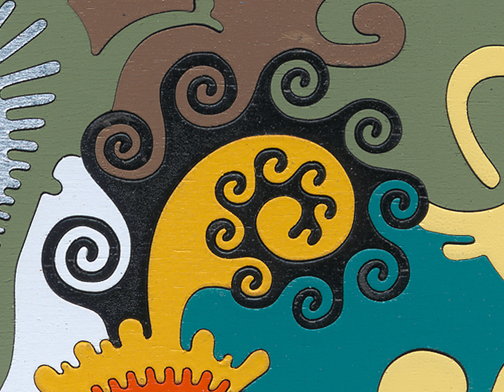
My elaborate "Same Direction Whirl Curl"
From a "Creative Showcase" puzzle completed on June 17, 2012
I cut these and all my Creative style pieces free-hand without templates. On October 1, 2013 I uploaded a video showing how I cut a "Same Direction Whirl Curl" puzzle piece. The piece in the picture, above, is the same one I held up to the camera before cutting another one.
John of Custom Puzzle Craft cuts a puzzle piece
Later Creative style puzzles:
Puzzle #436 - One of my first really major Creative style puzzle, quite spectacular, cut in May 2003.
Puzzle #564 - One of the most spectacular Creative style puzzles made by the end of year 2004.
These puzzles take me up to a full week to cut, and I have increased my Create style cutting prices substantially to reflect this fact.
In 2004 I created some "Art Objects" showing the Creative Style, see Art Objects.
Early Creative style puzzles:
Puzzle #34 - Hybrid Swirl Curl, Open Curl with first commercial appearance of some Creative Pieces
Puzzle #54 - First major Creative Style puzzle (Flow cutting method invented in one section, first eggs)
Puzzle #66 - Irregular shaped puzzle with Creative Pieces
Puzzle #76 - Same picture as #54, Most advanced Creative Style puzzle in year 2000
Grid Line Cutting Style (initially referred to as Grid with False Edges cutting style) including a discussion of Trick Edges and Trick Corners
My Grid Line cutting style owes its roots to one of my favorite jigsaw puzzles of all time: a 1000 piece Milton Bradley "Big Ben" cardboard puzzle designed in a style where virtually every piece has at least one straight edge. Thus, just about every interior piece is a trick edge or corner. It is a difficult puzzle to put together, particularly in the sky where the color is very similar from piece to piece. I still have the puzzle, but it has 14 pieces missing. (If anyone knows of a 1000 piece Milton Bradley "Big Ben" puzzle cut in this style with no missing pieces, please contact me. Big Ben 1000 piece puzzle were cut in this style during the 1950's. By 1963 at the latest, Milton Bradley changed the cutting style, eliminating all interior straight edges, ruining the series, in my opinion.)

Portion of "Off the Banks" - many interior pieces look like edge or corner pieces
When I first started to emulate this style in 2001, I developed a similar overall style, but the knobs were earlets and I called the style Earlet Grid. I cut just two puzzles in this style.

Puzzle #282 (June 2002), portion, showing "Earlet Grid" style
Many pieces are false edges and corners
In December 2003, I decided to drop the Earlet Grid style (I will still use the style if commissioned), and instead used regular knobs while continuing to add straight lines in the style. I first referred this style as Grid but later, to avoid confusion with Grid used for the standard grid style of "two ins" and "two outs" (see below), I renamed the style to Grid with False Edges in June 2004. In July, I decided this name was too wordy, and I came up with Grid Line, and this is the name that will last for the duration of Custom Puzzle Craft.
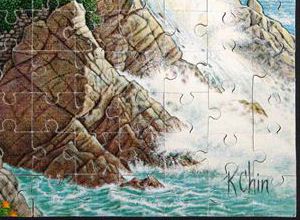
Grid Line style in puzzle #549, K. Chin's Lonely Cypress, Pebble Beach
There are two approaches to trick edges and corners.
The first is to cut interior pieces which look like edges and corners, as in Grid Line.
The second is to cut edges and corner pieces in such a way that it is not apparent that they are edges or corners. I have used this occasionally in my Swirl Curl puzzles. In the picture below, either piece in the lower right hand corner could have been the corner piece!

Puzzle #75, trick corner
This style is similar to Grid Line, except that the pieces have the standard "two ins" and "two outs" like this:

Standard "grid cut" puzzle piece
My first Grid Cut shaped puzzle piece was a Figure Piece in puzzle #34! I was commissioned to cut my first Grid Cut puzzle in January 2001 and I made my first large Grid Cut puzzle in May 2001, see Puzzle #118. In year 2002, I made several large Corporate puzzles with Grid Cut pieces, for a Trade Show and a Fund Raising Film. This style, is available by request.

Cats (figurals from puzzle #267, May 2002) play on a giant 3/4" thick "movie prop" Grid Cut piece I made in June 2002
Two movie prop pieces were shipped with a large 30" by 20" 54 piece Grid Cut puzzle.
In July 2002, I made my first "Radial Grid" puzzle, a circular puzzle with seven concentric rings of pieces.

Puzzle 291, July 2002, reverse, center - Radial Grid style, with experimental knobs
The puzzle was 23" in diameter and had 135 pieces
I've experimented a little in this style. The style is an easier style to cut than my other styles. It is similar to Long Round, with shortcuts taken to get from one place to another, with more "solid" interior spaces. As of the end of the year 2004, I've cut one puzzle in this style, Puzzle #566, Proverbidioms.

Exploration cutting in my Angular Style, unnumbered puzzle, Sept 25, 2004
Before my first commercial puzzle, I cut a number of "Geometric Style" puzzles - partially as an exercise in precision cutting. My Geometric Style puzzles had all of their pieces cut to predefined pattern, usually in a repeating form. This style of cut produced many pieces which were nearly identical in shape to each other - and for this reason, I have avoided this kind of cutting style in my commercial puzzles. This style is very time consuming to cut, and too easy to put together because once a pattern is learned while assembling a puzzle, one can easily reduce the scope of pieces to scan when looking for that missing piece! On the other hand, if nearly identical pieces are cut in a uniform color area, trying to find the right piece can be a bit tedious. However, I may be commissioned to cut such a puzzle.

Portion of a Geometric Pattern used for Puzzle #14
Some other Early Puzzles had geometric cuts too
Earlet Cutting Style
The "Earlet" cutting style is the main cutting style displayed on most puzzle maker websites. I am not planning to offer this style at this time. My Long Round style is the most similar style that I have.

Pictures copyright respective puzzle makers.
Color Line cutting is the process of cutting the edges of pieces along color boundaries within the jigsaw puzzle's picture. Color line cutting makes the puzzle more challenging as pictorial clues are reduced, leaving the shapes of the pieces as the primary clue.
If the color boundaries consist of straight lines, the puzzle can be quite hard, as areas of similar color have to be assembled before the assembler can figure out how the regions fit together. Some of the famous jigsaw puzzle brands like PAR and Pastime sometimes employed some line cutting.
Puzzle #23, "Green Dragon" has extensive color line cutting. Many of my puzzles have no color line cutting. I will almost always cut around small faces - see puzzle #46 (need to scroll down). If a puzzle has a lot of color line cutting, the puzzle will not necessarily interlock (won't be able to "pick up" the puzzle).
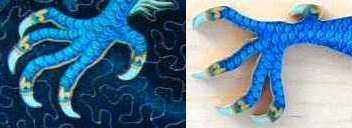
The claws from Puzzle #23 are examples of Color Line Cutting
This is a cutting technique in which the edge pieces do not interlock together, rather they connect "indirectly", that is, via interior pieces. This practice tends to discourage the habit of "putting the edge pieces together, first", and encourages work to start within particular interior areas, with the edges being placed almost as an afterthought.
Quite a few puzzles I made in the second half of 2000 and into 2001 were cut using this technique. Puzzle #21 is a 100% Indirect Interlocking Edge piece puzzles. Bob Armstrong is the one who introduced me to this cutting strategy. In more recent years, for example in 2004, I've moved away from this technique; most of my puzzles now have connecting edges as most customers prefer them. I'll sneak in a few indirects now and then.

Indirect Interlocking Edges within a Swirl Curl cut
Irregularly Shaped Jigsaw Puzzles & Scalloped Edges
Any puzzle which is not square or rectangular may be considered as having an "irregular" shape. However, oval or circular puzzles will usually be described as being "oval" or "circular". The "real" irregularly shaped puzzles are puzzles cutout to follow the artwork within the puzzle, commonly seen in floral arrangement puzzles, or perhaps cutout simply to add more challenge to the puzzle assembler. The shape of a given irregularly shaped puzzle tends to be unique.
Major Irregularly shaped Puzzles
Puzzle #32 - Owl shaped puzzle - My most popular puzzle in year 2000 - a "cool" puzzle!
Puzzle #66 - Multiple hearts shaped puzzle within interior trick edge
Puzzle #94 - The very beautiful "Wait.... I'll be right back..." puzzle - also my first puzzle with Scalloped edges.
Voids
A void is a space within a jigsaw puzzle that is not filled in with pieces. I cut my first puzzle with voids in May 2002, (#267).
Figure Pieces (also known as Whimsies and Shaped Pieces") and Word Pieces
See Figurals
Signature Piece
See Signature Piece
Framed or Tray Puzzles
A Framed puzzle is a puzzle cut in one of my cutting styles surrounded by a frame and a backing. Puzzle #78 is my first one - with the puzzle and frame cut from the same piece of wood
A Tray puzzle is generally a smaller puzzle with pieces cut out in shapes per custom request, not in one of my cutting styles. In April 2001, I had a large order for tray puzzles from a major corporation and I made 100 of them (a huge effort!) - a square tray with a circular interior cut into five "pie" pieces which when removed revealed a pie chart underneath.
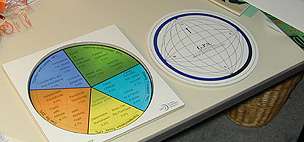
Tray Puzzle #1 (100 copies made), before the circle was cut into pie slices
Historical Section Flow Curl Cutting Style (formerly known as Open Curl)
On the way to developing the Creative Style, I had developed a cutting style I first called "Open Curl" and later "Flow Curl". One day, while cutting puzzle #25, a Swirl Curl puzzle, a particular piece was cut in a way that was decidedly different.

Piece from Puzzle #25 which spawned new possibilities.
The curls didn't tuck into the main part of the piece like regular Swirl Curl curls did. They were a bit more open and a bit more extended. This elongation and openness demanded investigation, and in my very next puzzle, puzzle #26, I launched "Open Curl".

Open Curl Pieces
From Puzzle #26 "Blue Bottle, Venice, Italy"
In the next several dozen puzzles, I cut just a few Open Curls, concentrating on Swirl Curl and the development Creative Style. While cutting Puzzle #54, a Creative puzzle (with a mixture of Swirl and Open Curl), there was some loud jazz being played from the building next door, and I during an Open Curl cutting "run" I really loosened up and cut the following sequence. It is in this puzzle that I invented the Flow Cutting method. Occasionally an intersecting cut will "flow" transparently through a piece and pick up again on the other side of the piece. I decided to rename the Open Curl style to Flow Curl. I apply my "Flow Cutting Method" in varying degrees to my Swirl Curl cutting style and extensively to my Creative cutting style.

Flow Curl - Spawned in Puzzle #54

Flow Curl in Puzzle #78
Major Open Curl / Flow Curl Puzzles
Puzzle #26 - First Open Curl
Puzzle #34 - Hybrid Swirl Curl, Open Curl with a few "creative pieces"
Puzzle #36 - Open Curl with "creative pieces"
Puzzle $54 - Genesis of Flow Curl - First Egg appearances
Puzzle #55 - First major Flow Curl puzzle - Lots of Eggs
As of late January 2002, Flow Curl is no longer offered as a separate cutting style.
What happened to Flow Curl? What happened is I decided that Flow Curl's "Flow Through" feature is more of a "principle" or "embellishment" I now call "Flow Cutting". Flow Cutting should not be considered a stand-alone style, rather it is something which can be used to enhance other cutting styles. Flow Curl was an evolution of Swirl Curl with two developments: 1) the opening of the Closed Curls into what I first called "Open Curl" and 2) the early development of "Flow Cutting".
I continue to cut Swirl Curl with mostly Closed Curls and with some Flow Cutting, there may be some Open Curls mixed in. I do not offer pure "Open Curl" as a style anymore (as shown in #26), could do so by request. I do continue to use Flow Cutting techniques, now quite a bit in Swirl Curl and extensively in Creative. Creative style, being much freer than Swirl Curl and can include more "Open curls" as well as other expressions. Flow Curl's famous Eggs usually show up in Creative Style cuts and sometimes (rarely) in Swirl Curl.
© John S. Stokes III - Puzzle Crafter & Webmaster
|